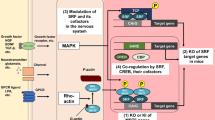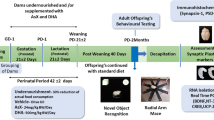The effects of implantation of cryopreserved placental explants (CPEs) on the behavioral phenomena were studied in adult young (6 months old) and in senescent (presenile ontogenetic period, 12 months old) mice; morphological characteristics of the cerebral structures were also examined in these animals. Implantation of CPEs significantly influenced the behavioral indices and adaptational capacities of senescent mice; the direction of such effects was sex-dependent. In male mice, manifestations of deadaptation (decreases in the mobility and exploration habits and an increase in anxiety) were observed, while in females the behavioral manifestations were opposite (positive). Implantation of CPEs led to partial smoothing of negative shifts in the morphological characteristics in the motor cortex and hippocampus of senescent mice. Therefore, CPEs can serve as a source of natural compounds and cell elements providing the activation of neurogenesis, formation of new neurons, and their proliferation in key structures of the brain. In prospect, CPE-based therapeutic agents can be used for the correction of age-related dysfunctions of the CNS.
Similar content being viewed by others
References
H. W. Mahncke, A. Bronstone, and M. M. Merzenich, “Brain plasticity and functional losses in the aged: scientific bases for a novel intervention,” Prog. Brain Res., 157, 81-109 (2006).
L. A. Mongiat and А. F. Schinder, “Adult neurogenesis and the plasticity of the dentate gyrus network,” Eur. J. Neurosci., 33, No. 6, 1055-1061 (2011).
E. L. Glisky, “Changes in cognitive function in human aging,” in: Brain Aging: Models, Methods, and Mechanisms, David R. Riddle (ed.), CRC Press /Taylor & Francis; Chapter 1 (2007).
N. V. Anisimov, Molecular and Physiological Mechanisms of Aging [in Russian], Vol. 1, Nauka, Saint Petersburg (2008).
J. O. Goh and D. C. Park, “Neuroplasticity and cognitive aging: the scaffolding theory of aging and cognition,” Restorat. Neurol. Neurosci., 27, No. 5, 391-403 (2009).
M. S. Penner, T. L. Roth, C. Barnes, and J. D. Sweatt, “An epigenic hypothesis of aging-related cognitive dysfunction,” Front. Aging Neurosci., 2, 9-11 (2010).
R. Coras, F. A. Siebzehnrubl, E. Pauli, et al., “Low proliferation capacities of adult hippocampal stem cells correlate with memory dysfunction in humans,” Brain, 133, 3359-3372 (2010).
E. Drapeau and D. Nora Abrous, “Stem cell review series: role of neurogenesis in age-related memory disorders,” Aging Cell, 7, No. 4, 569-589 (2008).
S. Nikolova, S. M. Stark, and C. E. Stark, “3T hippocampal glutamate-glutamine complex reflects verbal memory decline in aging,” Neurobiol. Aging, 54, 103-111 (2017).
J. E. Malberg, A. J. Eisch, E. J. Nestler, and R. S. Duman, “Chronic antidepressant treatment increases neurogenesis in adult rat hippocampus,” J. Neurosci., 20, 9104-9110 (2000).
N. Geribaldi-Doldаn, E. Flores-Giubi, M. Murillo-Carretero, et al., “12-deoxyphorbols promote adult neurogenesis by inducing neural progenitor cell proliferation via PKC activation,” Int. J. Neuropsychopharmacol., 19, No. 1, 1-14, pii: pyv085. doi: 10.1093/ijnp/pyv085 (2015).
N. Mochizuki, Y. Moriyama, N. Takagi, et al., “Intravenous injection of neural progenitor cells improves cerebral ischemia-induced learning dysfunction,” Biol. Pharm. Bull., 34, No. 2, 260-265 (2011).
A. S. Hill, A. Sahay, and R. Hen, “Increasing adult hippocampal neurogenesis is sufficient to reduce anxiety and depression-like behaviors,” Neuropsychopharmacology, 40, No. 10, 2368-2378 (2015).
M. V. Vedunova, T. A. Sakharnova, E. V. Mitroshina, et al., “Antihypoxic and neuroprotective properties of neurotrophic factors BDNF and GDNF in hypoxia in vitro and in vivo,” Sovrem. Tekhnol. Med., 6, No. 4, 1-10 (2014).
M. Nibuya, S. Morinobu, and R. S. Duman, “Regulation of BDNF and trkB mRNA in rat brain by chronic electroconvulsive seizure and antidepressant drug treatments,” J. Neurosci., 15, No. 11, 7539-7547 (1995).
N. D. Bull and P. F. Bartlett, “The adult mouse hippocampal progenitor is neurogenic but not a stem cell,” J. Neurosci., 25, No. 47, 10815-10821 (2005).
J. Chen and R. Shi, “Current advances in neurotrauma research: diagnosis, neuroprotection, and neurorepair,” Neural Regen. Res., 9, No. 11, 1093-1095 (2014).
F. Colleoni, A. J. Morash, T. Ashmore, et al., “Cryopreservation of placental biopsies for mitochondrial respiratory analysis,” Placentа, 33, No. 2, 122-123 (2012).
A. Garrod, G. Batra, I. Ptacek, et al., “Duration and method of tissue storage alters placental morphology – implications for clinical and research practice,” Placenta, 34, No. 11, 1116-1119 (2013).
C. Pipino, P. Shangaris, E. Resca, et al., “Placenta as a reservoir of stem cells: an underutilized resource,” Br. Med. Bull., 105, 43-68 (2013).
T. A. Astrelina, A. E. Gomzyakov, I. V. Kobzeva, et al., “Estimation of quality and safety of use of cryopreserved pluripotent mesenchymal stromal cells of the placenta in clinical practice,” Kletoch. Transplant. Tkan. Inzh., 8, No. 4, 82-87 (2013).
D. Pogozhykh, V. Prokopyuk, О. Pogozhykh, et al., “Influence of factors of cryopreservation and hypothermic storage on survival and functional parameters of multipotent stromal cells of placental origin,” PLoS One, 10, No. 10, e0139834 (2015).
M. D. Vasilyuk, A. G. Shevchuk, E. I. Romanishin, et al., “Transplantation of cryoplacental tissues in treatment and prevention of the appearance of syndrome of diabetic foot,” Transplantologiya, 4, No. 1, 134-135 (2003).
V. Yu. Prokopyuk, O. V Falko., I. B. Musatova, et al., “Low temperature preservation and storage of placental biological derivatives,” Probl. Cryobiol. Cryomed., 25, No. 4, 291-310 (2015).
N. O. Schevchenko, K. V. Somova, V. V. Volina, et al., “Dynamics of activity and duration of functioning of cryopreserved cryoextract, placental cells and fragments in the organism of experimental animals,” Morphologia, 10, No. 2, 93-98 (2016).
V. Yu. Prokopyuk, O. S. Prokopyuk, I. B. Musatova, et al., “Safety of placental, umbilical cord and fetal membrane explants after cryopreservation,” Cell Organ Transplantol., 3, No. 1, 34-38 (2015).
Preclinical Studies of Medicinal Agents [in Ukrainian], O. V. Stefanov (ed.), Publishing House “Avicenna,” Kyiv (2001).
V. I. Dontsov, Experimental Gerontology: Method for the Study of Aging [in Russian], Al’teks, Moscow (2011).
I. B. Musatova, O. S. Prokopyuk, V. V. Volina, and V. Yu. Prokopyuk, “Creation of cryoprotective media for preservation of placental tissue explants,” Biotechnol. Acta, 6, No. 6, 132-138 (2013).
T. A. Voronina and S. B. Seredenin, “Experimental study of preparations with tranquillizing (anxiolytic) effect: guidelines,” Vedomosti Farmakol. Kom. MZ Ross. Fed., No. 2, 19-25 (1998).
M. Faizi, P. L. Bader, N. Saw, et al., “Thy1-hAPPLond/Swe+ mouse model of Alzheimer’s disease displays broad behavioral deficits in sensorimotor, cognitive and social function,” Brain Behav., 2, No. 2, 142-154 (2012).
Methods of Behavior Analysis in Neuroscience, 2nd edn., Front. Neurosci., Jerry J. J. Buccafusco (ed.), Medical College of Georgia, Augusta, CRC Press / Taylor and Francis (2009).
D. É. Korzhevskii and A. V. Gilarov, Basic Foundation of Histological Technique. Practical Guide [in Russian], Spetslit, Saint Petersburg (2010).
D. F. Avgustinovich and I. L. Kovalenko, “Formation of pathology of behavior in С57BL/6J female mice under the influence of long-lasting psychoemotional action,” Sechenov Ros. Fiziol. Zh., 90, No. 11, 1324-1336 (2004).
A. V. Mel’nikov, M. A. Kulikov, M. R. Novikova, and E. V. Sharova, “Choice of indices of behavioral tests for estimation of typological peculiarities of behavior of rats,” Zh. Vysch. Nerv. Deyat., 54, No. 5, 712-717 (2004).
P. A. Russe, “Relationships between exploratory behaviour and fear: a review,” Brit. J. Psychol., 64, 417-433 (1973).
A. Carobrez and L. Bertoglio, “Ethological and temporal analyses of anxiety-like behavior: the elevated plusmaze model 20 years on,” Neurosci. Biobehav. Rev., 29, No. 8, 1193-1205 (2005).
I. P. Levshina, V. N. Mats, N. V. Pasikova, and N. N. Shuikin, “Comparison between the behavior of rats after long-lasting immobilization and structural modifications in the motor cortex and hippocampus,” Zh. Vyssh., Nerv. Deyat., 60, No. 2, 184-191 (2010).
O. A. Gromova, I. Yu. Torshin, E. A. Dibrova, et al., “World experience in the use of preparations obtained from the human placenta: results of clinical and experimental studies. Review,” Plast. Khir. Kosmetol., 3, 385-576 (2011).
O. S. Prokopyuk, V. Yu. Prokopyuk, N. M. Pasieshvili, et al., “Implantation of cryopreserved human placental fragments restores prooxidant-antioxidant balance in experimental animals of late ontogeny,” Cryobiol. Cryomed., 27, No. 1, 61-70 (2017).
O. Parolini, F. Alviano, G. P. Bagnara, et al., “Concise review: isolation and characterization of cells from human term placenta: outcome of the first international ‘Workshop on Placenta Derived Stem Cells’,” Stem Cells, 26, No. 2, 300-311 (2008).
G. Tonello, M. Daglio, N. Zaccarelli, et al., “Characterization and quantitation of the active polynucleotide fraction (PDRN) from human placenta, a tissue repair stimulating agent,” J. Pharm. Biomed. Anal., 14, 1555-1560 (1996).
K. Yamada and T. Nabeshima, “Brain-derived neurotrophic factor/TrkB signaling in memory processes,” J. Pharmacol. Sci., 91, 267-270 (2003).
K. Takuma, H. Mizoguchi, and Y. Funatsu, “Placental extract improves hippocampal neuronal loss and fear memory impairment resulting from chronic restraint stress in ovariectomized mice,” J. Pharmacol. Sci., 120, 89-97 (2012).
Author information
Authors and Affiliations
Corresponding authors
Rights and permissions
About this article
Cite this article
Musatova, I.B., Volina, V.V., Chub, O.V. et al. Effects of Implantation of Cryopreserved Placental Explants on the Behavioral Indices and Morphological Characteristics of the Cerebral Structures in Senescent Mice. Neurophysiology 49, 363–371 (2017). https://doi.org/10.1007/s11062-018-9696-4
Received:
Published:
Issue Date:
DOI: https://doi.org/10.1007/s11062-018-9696-4




